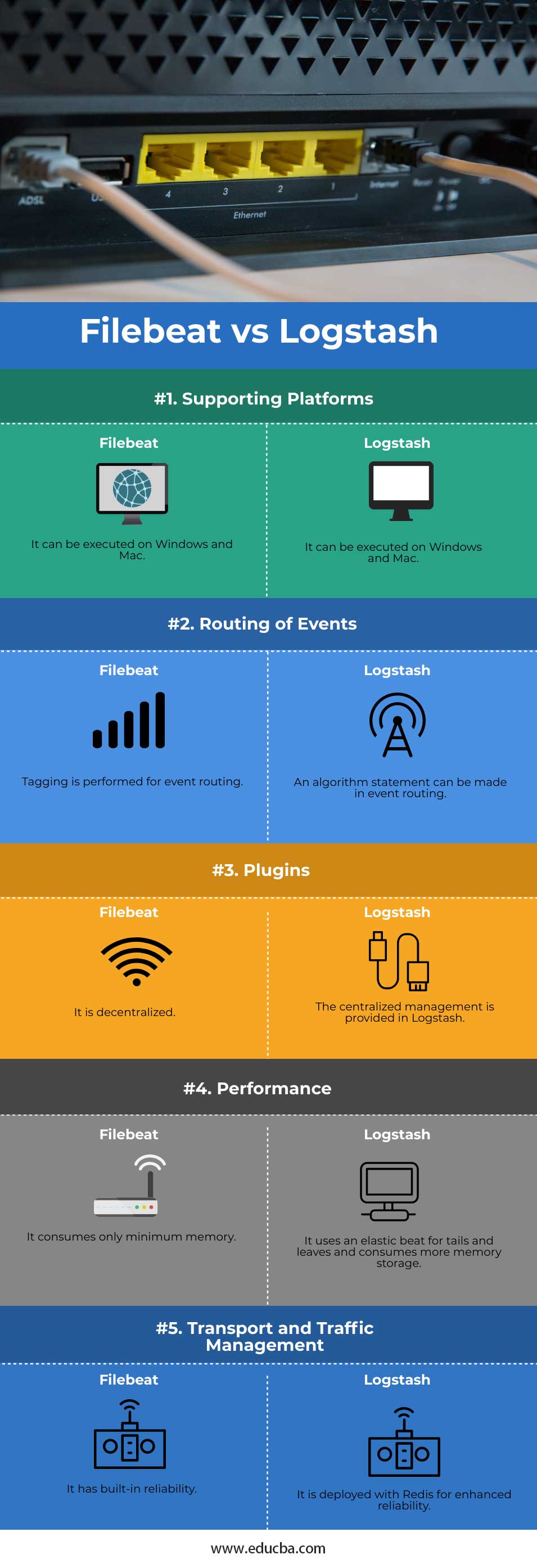Updated April 6, 2023

Difference Between Filebeat vs Logstash
Filebeat and Logstash provide the inconsequential shipper for centralizing and forwarding the log information. It supports maintaining simple objects by providing a very light way to manage and centralize the files, folders, and logs. In other terms, Logstash is described as Gather, Parse, and augment the data. The important difference between Logstash and Filebeat is their functionalities, and Filebeat consumes fewer resources. But in general, Logstash consumes a variety of inputs, and the specialized beats do the work of gathering the data with minimum RAM and CPU. The key differences and comparisons between the two are discussed in this article.
Head to Head Comparison between Filebeat vs Logstash (Infographics)
Below are the top 5 comparisons between Filebeat vs Logstash:
Key differences between Filebeat vs Logstash
The major differences like their functions, advantages, use cases and limitations are discussed below.
1. Definition
The quote old is gold is a perfect fit for Logstash because of its traditional functionality. It has a variety of plugins, codecs, filters, inputs, and outputs. The amount of data consumed can be vast and enriched as per the consumer’s requirement, and it can also distribute it to numerous destinations. As an important member of the beat family, the filebeat is a lightweight shipper log that came to life to overcome the shortcomings of Logstash. It was specially made to inconsequential log shipper to force into Kafka, Elasticsearch or Logstash.
2. Applications & Use Cases
It is generally used for gathering, parsing, and saving the logs for upcoming usage as a solution to the log management system. The flexibility and its abundance make Logstash as a reliable tool for prototyping and parsing complex data objects. If the user has big servers, it is mandated to install Logstash on everything which doesn’t need more buffering. If the user wants to tailor the files, it should be done manually as the file cannot make itself a buffer as it remembers where it should be resumed. If the user has small servers, the installing of Logstash is no other option as it needs a lightweight log ship that forces the data to a bucket of Elasticsearch to one or more Logstash servers. If the user wants to forward the logging project, it must alter the log shipper due to its cost or performance. Suppose the user wants Elasticsearch to ingest to parse and enrich as it assumes that the functionality or performance of Ingest just fits the user requirement. It curbs them into Redis or Kafka to ship other Logstash or customize Kafka’s consumer to ship and enhance. It assumes and selects the shipper fit on performance and functionality. It can also ship to Logstash, which is relied on buffer instead of Redis or Kafka. It is fault tolerance because of rigid flexibility.
3. Merits
The key point of Logstash is its flexibility because of the numerous count of plugins. It has widespread community support with brief documentation and a very straight and simple configuration, which is applicable in different use-cases. It paves to a worthy cycle where the user can get online solutions for performing any process. Filebeat is a minimum binary with no other dependencies as it takes only little resources, and it’s simply reliable. It is simple as there are only a few things to be considered, and there are no chances of going wrong. There are many knobs to consider functionalities. It is aggressive in searching any updated files to tail the closed one, and there are no changes to be made in the file. When it has a start option, the Filebeat is updated with modules and has an accurate log type.
5. Demerits
The biggest disadvantage of Logstash is its resource consumption which is a default storage size of 1GB. Though its performance has been updated over the years, it works slowly when compared to its effective alternatives. But the developer’s team finds some important benchmarks to rsyslog and filebeat the ingest node of elasticsearch. The scope of filebeat is very constrained as it has a problem to rectify in case of any issues. Suppose the user wants to use the pipeline of Logstash when there are any performance issues. Due to this, the updating scope of the Filebeat is constrained. It sends only the log data to Elasticsearch and Logstash and now can transfer the data to Redis and Kafka. It can also perform some filtering and drop the events to append the meta-information into it.
6. Performance
Logstash is a bit complex if there is high traffic deployment when the servers of Logstash need to be compared with Elasticsearch. It eases the tough process to multiple center Logstash boxes by maintaining the simple logging servers and consuming and configuring only the fewer resources. It supports the Logstash when it is available with configured on-disk buffers and in-memory caches. Whereas filebeat, the Apache module has a point that has a default option to access the error log path and configure the log type. The ingest node to parse can configure, edit, and map the Elasticsearch to deploy the dashboard of Kibana to analyze the object like response code and time to calculate breaktime.
Comparison Table of Filebeat vs Logstash
The table below summarizes the comparisons between Filebeat vs Logstash:
| Attributes | Filebeat | Logstash |
| Supporting Platforms | It can be executed on Windows and Mac. | It can be executed on Windows and Mac. |
| Routing of Events | Tagging is performed for event routing. | An algorithm statement can be made in event routing. |
| plugins | It is decentralized. | The centralized management is provided in Logstash. |
| Performance | It consumes only minimum memory. | It uses an elastic beat for tails and leaves and consumes more memory storage. |
| Transport and Traffic Management | It has built-in reliability. | It is deployed with Redis for enhanced reliability. |
Conclusion
When selecting the performance of Logstash, the user should consider the need for throughput and estimation as it predicts the cost spent on the hardware of Logstash. The use case of filebeat has limited application to choose the log into files or either. It can also ship instant to elastic search. It works when the user wants to grep or log them to JSON or parse JSON.
Recommended Articles
This is a guide to the top differences between Filebeat vs Logstash. Here we discuss the key differences between Filebeat vs Logstash with infographics and a comparison table. You may also have a look at the following articles to learn more –

